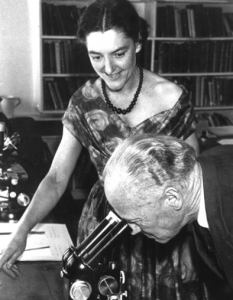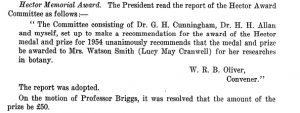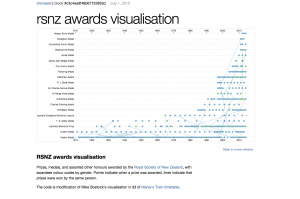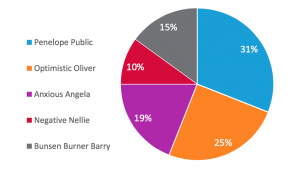by Kate Hannah
In 1947 Elizabeth Joan Batham made New Zealand science history when she became the first woman to win a Royal Society of New Zealand prize, medal, or award.[i] When she was named the 1947 recipient of the Hamilton Memorial Prize “for the encouragement of an early career researcher currently based in New Zealand for scientific or technological research in New Zealand”, that prize, named after Augustus Hamilton, the 1909-1910 President of the Society, had been running for 24 years.
The first award established by the Society, in 1911, the Hutton Medal for earth, plant, and animal sciences (named for Captain FW Hutton FRS, 1836-1905, who was the first President, 1904-05) is now awarded annually, rotating through the disciplines, but between 1911- 1995 was awarded every three years. More medals and awards were established over the next 104 years, so that in 2015 we now have 12 annual awards and another 9 awards biennially, triennially, or irregularly.
Back to Betty Batham. She was responsible for the redevelopment of what is now the Portobello Marine Biological Station, University of Otago, which during her tenure (1950-1974) gained “an international reputation, although for many years it was little involved in routine teaching and research activities of the university,”[ii] which seems to be her successor, John Jillet’s careful way of summarising the sexism Batham faced.[iii]
For her efforts, she was made a Fellow of the Royal Society of New Zealand in 1962, and the Department of Marine Science at the University of Otago set up a prize in her name in 2004. The deep-sea vessel at Portobello that provides visitors with a virtual benthic (sea-floor) experience is called the DSV Batham.[iv]
The next woman to win a Royal Society of New Zealand prize was Lucy Cranwell Smith, awarded the Hector Medal in 1954:
The Hector Medal’s citation is currently “for outstanding work in chemical, physical, or mathematical and information sciences … awarded annually in rotation among the disciplines.”[vi] It was previously broader: “for plant sciences, chemical sciences, human sciences, solid earth sciences, mathematical physical and engineering sciences, and animal sciences”.[vii]
Lucy Cranwell Smith, who went on to have a highly successful career in palynology at the University of Arizona, was the first woman to win the Hector Medal. It has been won by 2 other women in the subsequent half century. Dame Patricia Bergquist, the eminent zoologist and anatomist, was awarded the Hector Medal in 1989 for her work on invertebrate anatomy, and was made a Dame in 1994 for her contribution to science. In 2012, Margaret Brimble was the Hector Medal recipient, for “excellence in chemical sciences.”[viii]
The Hector Medal, named for Sir James Hector, is the second oldest of the Royal Society of New Zealand’s medals – it was first awarded in 1912, and since then, has been awarded to 99 men, and 3 women. The oldest award – the Hutton Medal established in 1911 – has been awarded to 41 men and 2 women in its over 100-year history. The Humanities Aronui Medal (2011), Mason Durie Medal (2012), Pickering Medal (2004), Thomson Medal (1985), Cooper Medal (1958), R.J. Scott Medal (1997), Hercus Medal (1997), and the T.K.Sidey Medal (1933) have all never been awarded to a woman.
Six of the male Hector Medal winners now have other Royal Society awards or prizes named after them: Leonard Cockayne, the 1912 winner, and Lucy Cranwell Smith’s mentor, for whom the Leonard Cockayne Memorial Lecture Series Award was named; Ernest Rutherford, 1916 winner, the Rutherford Medal. Peter Buck (Te Rangi Hiroa) was awarded the Hector Medal in 1932, and since 1997 the Te Rangi Hiroa Medal has been presented for outstanding work in the social sciences; Charles Fleming received the Hector Medal in 1963 – and the Royal Society’s Fleming Award was inaugurated in 1989; Trevor Hatherton, for whom the Hatherton Award is named, won the Hector Medal in 1981; in 1998, Paul Callaghan, in whose name the Callaghan Medal for Science Communication was commissioned, was awarded the Hector Medal.
Women do have a prize of their own, of a sort – or at least one of the 21 prizes and awards is named after a woman. The Dame Joan Metge Medal, commissioned in 2008, celebrates outstanding contributions in the social sciences, and has been won by women 3 out of the 4 times it has been awarded. However, this success rate for women does not reflect the prizes and awards presented by New Zealand’s preeminent science and research organisation accurately. Over the last 104 years, only 10% of all prizes have been awarded to women; with most success coming in the early career award – the Hamilton Memorial Medal, which women have won 11 times since 1923. Of the 19 prizes that are named after a person, just one of them is named after a woman, and 8 of the 21 available prizes and awards have NEVER been awarded to a woman.
Higher percentages of women have won the Dame Joan Metge Medal (75%) and the Pou Aronui Award (28%), and the Te Rangi Hiroa Medal (75%), but these prizes are in the humanities and social sciences, discipline areas generally perceived to have better representation of women – but as the May 2015 update to the Athena SWAN Charter notes:
We commit to addressing unequal gender representation across academic disciplines and professional and support functions. In this we recognise disciplinary differences including:
- the relative underrepresentation of women in senior roles in arts, humanities, social sciences, business and law (AHSSBL)[x]
Placed in the context of the relative underrepresentation of women in senior academic roles in humanities and social sciences, that no woman has ever won the Humanities Aronui Medal – for work of outstanding merit in the humanities, or the Mason Durie Medal– “awarded annually to the nation’s preemminent social scientist”[xi] is contextualised within a gap between the perceived relative equity in the humanities and social sciences, and the actual numbers of women in senior roles across those discipline areas.
It’s not hard to see that we have a problem. 8% women prizewinners doesn’t reflect the gender breakdown in society as a whole, but neither does it reflect the breakdown in science. Looking at a couple of individual prizes helps highlight that. Many would not be surprised that the Pickering Medal, technology medal for excellence, has never been awarded to a woman. But neither has the Sir Charles Hercus Medal, for excellence in molecular and cellular sciences, biomedical science or clinical science and public health– fields that many women have made an enormous contribution to.
Things have been getting better – more women are winning more prizes now than ever before. Since 1999 there has been at least 1 female prizewinner per year, a total of 25 prizes to 23 women in 15 years.[xii] Of those, however, 9 have been the Hamilton Memorial Prize (early career) or the Hatherton Award (best paper by a PhD student). That’s still only 16 senior prizes going to 14 women. One swallow does not make a summer, and all that. There’s still those 8 prizes that have never been awarded to a woman, and the T.K Sidey Medal’s been going since 1933. Many outstanding women – some of whom I have named here – have won a singular prize, and then gone on to great careers but, unlike their male counterparts, there’s no prize named for them.
In the UK, WISE – a campaign to promote women in science, technology, and engineering released a summary report in November 2014, “Not for people like me?” under-represented groups in science, technology, and engineering; this coincided with the Nielsen Report on Public Attitudes Towards Science and Technology, commissioned by New Zealand’s Ministry of Business, Innovation, and Employment as part of The Nation of Curious Minds/Science and Society Project.
The WISE report states:
Girls … need to resolve the conflict between self-identity and STEM identity in order to see STEM as offering careers ‘for people like me’[xiii]
The Nielsen Report summarises public attitudes towards science and technology with the creation of 5 personas[xiv], representations of different segments of society:
You’ll note that while 3 of these personas are female, both segments of society with the most negative attitude towards science and technology are classified as female; in fact Nielsen go on to say:
In order to lift public engagement with science and technology we suggest that MBIE target the Optimistic Oliver and Penelope Public segments…we believe the Anxious Annie and especially the Negative Nellie group will be more difficult targets to convince[xv]
From those people we, as a scientific community, choose to honour and recognise with medals and awards, through the names given to those prizes, to the names selected to categorise segments of society when discussing public engagement with science, we seem to be saying to young women and girls “not for people like you.”
[i] What is now called the Royal Society of New Zealand was established as the New Zealand Institute in 1867, and renamed the Royal Society of New Zealand in 1933. For the purposes of clarity, this paper will refer to the Royal Society of New Zealand for both.
[ii] Jillet, John. ‘Batham, Elizabeth Joan,’ from The Dictionary of New Zealand Biography. Te Ara – the Encyclopedia of New Zealand, updated 4 June 2013
http://www.teara.govt.nz/mi/biographies/5b13/batham-elizabeth-joan
[iii]http://www.nzmaritimeindex.org.nz//izperson.php?personid=999992497&SourceID=&person=E.B.J.&rid=0&refid=&hit=6
[iv] Betty Batham, in the laboratory, 1962 http://www.teara.govt.nz/en/photograph/36056/in-the-laboratory-1962
[v] Transactions and Proceedings of the Royal Society of New Zealand, 1868-1961, vo. 82, 1954-1955, National Library of New Zealand. http://rsnz.natlib.govt.nz/volume/rsnz_82/rsnz_82_03_005740.html
[vi]Hector Medal citation, http://www.royalsociety.org.nz/programmes/awards/hector-medal/
[vii] Background to the Hector Medal, Royal Society of New Zealand, http://www.royalsociety.org.nz/programmes/awards/hector-medal/background/
[viii] Margaret Brimble, Hector Medal citation, 2012, http://www.royalsociety.org.nz/programmes/awards/hector-medal/recipients/
[ix] O’Neale, Dion. RSNZ Awards Visualisation http://bl.ocks.org/droneale/c3c4ea9f48b67722833d
[x] The Athena SWAN Charter, http://www.ecu.ac.uk/equality-charters/athena-swan/about-athena-swan/
[xi] Mason Durie Medal citation, http://www.royalsociety.org.nz/programmes/awards/mason-durie-medal/
[xii] In 2012, Professor Margaret Brimble won three prizes – the Hector, MacDiarmid, and Rutherford Medals.
[xiii] MacDonald, Averil. “Not for people like me?” Under-represented groups in science, technology and engineering, WISE, November 2014, p. 6 https://www.wisecampaign.org.uk/uploads/wise/files/not_for_people_like_me.pdf
[xiv] Report on Public Attitudes towards Science and Technology, Nielsen, MBIE, November 2014, p. 11 http://www.msi.govt.nz/assets/MSI/Update-me/Science-in-society-project/report-on-public-attitudes-towards-science-and-technology.pdf
[xv] ibid, p. 13




